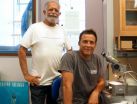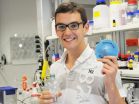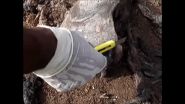(Press-News.org) From AGU's blogs: Oso disaster had its roots in earlier landslides
A research team tasked with being some of the first scientists and engineers to evaluate extreme events has issued its findings on disastrous Oso, Washington, landslide. The report studies the conditions and causes related to the March 22 mudslide that killed 43 people and destroyed the Steelhead Haven neighborhood in Oso, Washington. The team from the Geotechnical Extreme Events Reconnaissance (GEER) Association, funded by the National Science Foundation, determined that intense rainfall in the three weeks before the slide likely was a major issue, but factors such as altered groundwater migration, weakened soil consistency because of previous landslides and changes in hillside stresses played key roles.
From this week's Eos: Reducing Rockfall Risk in Yosemite National Park
The glacially sculpted granite walls of Yosemite Valley attract 4 million visitors a year, but rockfalls from these cliffs pose substantial hazards. Responding to new studies, the National Park Service recently took actions to reduce the human risk posed by rockfalls in Yosemite National Park.
From AGU's journals: A new earthquake model may explain discrepancies in San Andreas fault slip
Investigating the earthquake hazards of the San Andreas Fault System requires an accurate understanding of accumulating stresses and the history of past earthquakes. Faults tend to go through an "earthquake cycle"—locking and accumulating stress, rupturing in an earthquake, and locking again in a well-accepted process known as "elastic rebound." One of the key factors in preparing for California's next "Big One" is estimating the fault slip rate, the speed at which one side of the San Andreas Fault is moving past the other.
Broadly speaking, there are two ways geoscientists study fault slip. Geologists formulate estimates by studying geologic features at key locations to study slip rates through time. Geodesists, scientists who measure the size and shape of the planet, use technologies like GPS and satellite radar interferometry to estimate the slip rate, estimates which often differ from the geologists' estimations.
In a recent study by Tong et al., the authors develop a new three-dimensional viscoelastic earthquake cycle model that represents 41 major fault segments of the San Andreas Fault System. While previous research has suggested that there are discrepancies between the fault slip rates along the San Andreas as measured by geologic and geodetic means, the authors find that there are no significant differences between the two measures if the thickness of the tectonic plate and viscoelasticity are taken into account. The authors find that the geodetic slip rate depends on the plate thickness over the San Andreas, a variable lacking in previous research.
The team notes that of the 41 studied faults within the San Andreas Fault system, a small number do in fact have disagreements between the geologic and geodetic slip rates. These differences could be attributed to inadequate data coverage or to incomplete knowledge of the fault structures or the chronological sequence of past events.
INFORMATION:
Click here for the online version of This Week From AGU.
Click here to register for access to AGU journal papers and Eos, the newspaper of the Earth and space sciences.
The American Geophysical Union is dedicated to advancing the Earth and space sciences for the benefit of humanity through its scholarly publications, conferences, and outreach programs. AGU is a not-for-profit, professional, scientific organization representing more than 62,000 members in 144 countries. Join our conversation on Facebook, Twitter, YouTube, and other social media channels.
This week from AGU: New Oso report, rockfall in Yosemite, and earthquake models
2014-07-23
ELSE PRESS RELEASES FROM THIS DATE:
York University researchers use bird 'backpacks' to put wood thrushes migration on the map
2014-07-23
TORONTO, July 23, 2014 – Migratory songbirds are disappearing, and though conservationists are examining several possible reasons such as climate change, loss of habitat, acid rain and light pollution, a key piece of the puzzle has remained missing: where do these birds go once they leave their breeding sites, and what threats may they be encountering along the way?
To answer this question, a team of researchers out of York University have created the first ever migratory connectivity map produced for a songbird, using tracking from both breeding and winter sites. They ...
Diseases of another kind
2014-07-23
The drought that has the entire country in its grip is affecting more than the color of people's lawns. It may also be responsible for the proliferation of a heat-loving amoeba commonly found in warm freshwater bodies, such as lakes, rivers and hot springs, which the drought has made warmer than usual this year.
A 9-year-old Kansas girl recently died of an infection caused by this parasite after swimming in several area lakes. The amoeba enters the body through the nose of an individual and travels to the brain. Nose plugs can lower the odds of this rare but fatal pathogen ...
ETH student develops filter for clean water around the world
2014-07-23
Roughly 780 million people around the world have no access to clean drinking water. According to the World Health Organization (WHO), 3.4 million people die from water-related diseases every year. ETH student Jeremy Nussbaumer set himself the goal of making a contribution to solving this problem. Working with researchers from a group led by Wendelin Stark, head of the Functional Materials Laboratory, the 23-year-old spent a year researching a membrane filter and developing a prototype.
"What makes our DrinkPure filter unique is that you can screw it on to virtually any ...
Ketamine can be a wonder drug for ER patients and their physicians
2014-07-23
WASHINGTON -- For critically ill patients arriving at the emergency department, the drug ketamine can safely provide analgesia, sedation and amnesia for rapid, life-saving intubation, despite decades-old studies that suggested it raised intracranial pressure. The results of a systematic review of 10 recent studies of what many emergency physicians regard as a "wonder drug" are published online in Annals of Emergency Medicine "The Effect of Ketamine on Intracranial and Cerebral Perfusion Pressure and Health Outcomes: A Systematic Review."
"Apprehension for many years ...
Climate change and the soil
2014-07-23
Washington, DC -- The planet's soil releases about 60 billion tons of carbon into the atmosphere each year, which is far more than that released by burning fossil fuels. This happens through a process called soil respiration. This enormous release of carbon is balanced by carbon coming into the soil system from falling leaves and other plant matter, as well as by the underground activities of plant roots.
Short-term warming studies have documented that rising temperatures increase the rate of soil respiration. As a result, scientists have worried that global warming ...
AGU: Voyager spacecraft might not have reached interstellar space
2014-07-23
WASHINGTON, D.C. -- In 2012, the Voyager mission team announced that the Voyager 1 spacecraft had passed into interstellar space, traveling further from Earth than any other manmade object.
But, in the nearly two years since that historic announcement, and despite subsequent observations backing it up, uncertainty about whether Voyager 1 really crossed the threshold continues. There are some scientists who say that the spacecraft is still within the heliosphere – the region of space dominated by the Sun and its wind of energetic particles – and has not yet reached the ...
Wide-faced men negotiate nearly $2,200 larger signing bonus
2014-07-23
RIVERSIDE, Calif. -- Having a wider face helps men when they negotiate for themselves but hurts them when they are negotiating in a situation that requires compromise. Additionally, men who are more attractive are better collaborators compared to less attractive men.
Those are among the findings outlined in a just published paper co-authored by Michael P. Haselhuhn and Elaine M. Wong, assistant professors of management at the University of California, Riverside's School of Business Administration. The paper describes four negotiation simulations set up by the authors ...
This week from AGU: Oso report, rockfall in Yosemite Park, and a new ear
2014-07-23
From AGU's blogs: Oso disaster had its roots in earlier landslides
A research team tasked with being some of the first scientists and engineers to evaluate extreme events has issued its findings on disastrous Oso, Washington, landslide. The report studies the conditions and causes related to the March 22 mudslide that killed 43 people and destroyed the Steelhead Haven neighborhood in Oso, Washington. The team from the Geotechnical Extreme Events Reconnaissance (GEER) Association, funded by the National Science Foundation, determined that intense rainfall in the three ...
Protein evolution follows a modular principle
2014-07-23
This news release is available in German.
Proteins impart shape and stability to cells, drive metabolic processes and transmit signals. To perform these manifold tasks, they fold into complex three-dimensional shapes. Scientists at the Max Planck Institute for Developmental Biology in Tübingen have now discovered that proteins can be constructed of similar amino acid chains even when their three-dimensional shapes differ significantly. This suggests that the proteins that exist today arose from common precursors. Presumably, in the course of evolution they were ...
Dead body feeding larvae useful in forensic investigations
2014-07-23
VIDEO:
This image depicts Chrysomya megacephala larvae on decomposing fish.
Click here for more information.
Non-biting blow fly Chrysomya megacephala is commonly found in dead bodies and is used in forensic investigations to determine the time of death, referred to as the post mortem interval. A report of synanthropic derived form of C. megacephala from Tamil Nadu is provided for the first time based on morphological features and molecular characterization through generation ...





